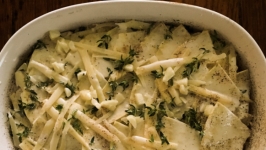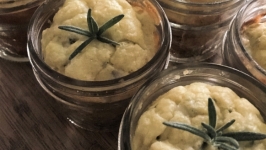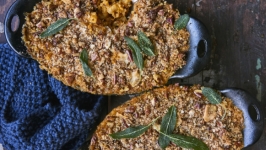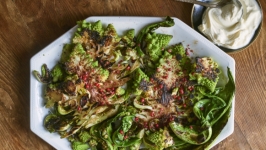Winter Vegetable Feast
When non-residents think of the Delmarva Peninsula, memories of summer heat and crashing waves generally come to mind. While beaches and warm-weather getaways are something to be celebrated, Delmarva does not vanish into the sea during the winter season. The same reality holds true for the region’s agricultural production and foodways as well. Many small growers are expanding the diversity of their offerings as demand in the shoulder seasons grows.
Although grocery stores offer us the ability to eat tomatoes in January, eating seasonally helps us to develop a greater connection to our local region. Winter may not offer the wide diversity of vegetables available in other seasons, but it does have its own bounty and unique flavors to offer. While most farmers’ markets on Delmarva are closed until spring, growing demand is encouraging longer seasons for some markets and you can find year-round markets in several communities. It may be easier to find these fruits and vegetables through a winter CSA or by reaching out directly to a local produce farmer in your community. If you see any of these at a market stall, stock up as they will store throughout the winter for you, pumpkins on the counter and the roots in your refrigerator drawer. However you go about it, support your local growers and consider adding one the following cold-weather vegetables to your winter meals —the rewards are worth the effort.
Parsnip
Considering the shape and size of the parsnip, it will come as little surprise that this tuberous root is closely related to the carrot. In fact, carrots, parsnips, and celeriac are all members of the parsley family. Parsnips are native to Europe and Asia and were widely used both as a vegetable and a sweetener before the arrival of cane sugar. Introduced to Delmarva during the early 17th century, parsnips became a staple of colonial and Native American cuisine until they were almost completely replaced by the wide adoption of the potato. Although parsnips have remained popular in Scandinavia, Diane Morgan, author of the cookbook Roots, suggests that it was the rise of the small farm CSA that brought this vegetable back into North American use. These vitamin C and potassium rich roots can be roasted, steamed, sautéed, and basically cooked in the same manner as carrots. The flavor though is so much sweeter, nuttier, and earthier, pairing well with the warming flavors of winter. Like any root, they will be sweeter if harvested after the first frost.
Celery Root
These softball sized orbs of gnarled root look as though they would be quite at home on a shelf in Hogwarts or tucked away in some Hobbit’s larder. Although many people associate celery with brunch cocktails or peanut-buttery snacks, the plant’s root actually has an older history of human consumption than the stalk. Originally prized for medicinal use, celery root was collected and cultivated on multiple continents and was referenced in Homer’s Odyssey almost three-thousand years ago. With a flavor of an aromatic potato, celery root can be used as a substitute in a mash or in other starchy cuisine. Since it is not a member of the nightshade family, celery root can also be eaten raw and works well as a shredded addition to a salad. It has a lovely bright, and cheerful flavor welcome in the depths of winter.
Pumpkin
Between front-porch decorations and Thanksgiving pies, the pumpkin holds a deeply iconic association with autumn. With that in mind, pumpkins are a winter squash harvested on Delmarva during the late summer. The reason that it is called a winter squash, along with other tasty varieties like the butternut and delicata, is that the pumpkin is ideally cured in the open air, which will allow the fruit to last well into the winter without any refrigeration. In its 9,000-year history of human consumption, the pumpkin was traditionally saved and eaten when frost and cold made other vegetables difficult to grow. Pumpkins offer a moderate amount of vitamins A and C, and they are more versatile than many people acknowledge. With a larger pumpkin you can bake the whole thing and then freeze the flesh as a puree for soups and pies. Smaller ones are well suited to being roasted or even sautéed as you would any other winter squash. Keep your eye out for special cooking varieties, our favorite being the sweet and silky heirloom ‘Winter Luxury’.












